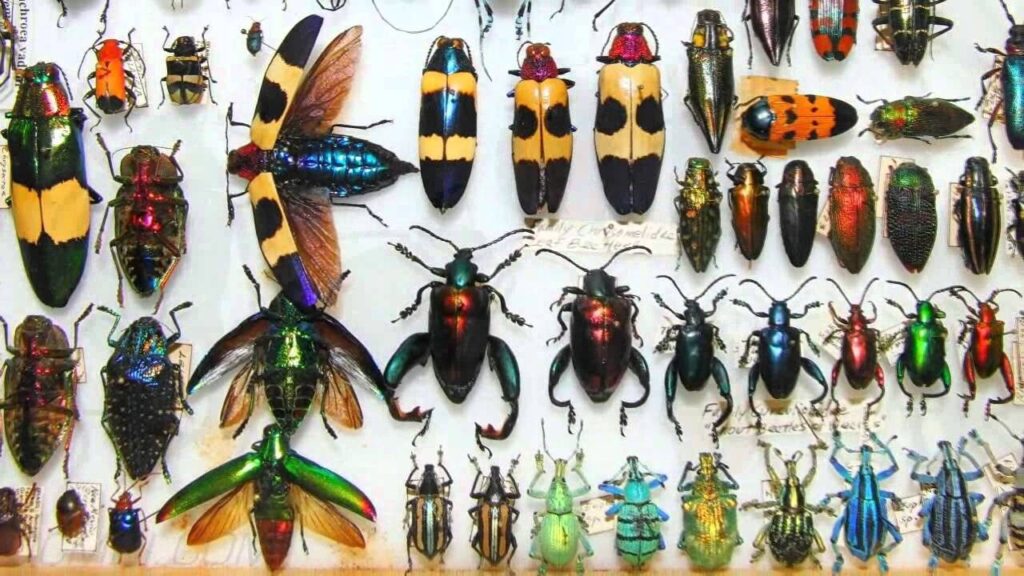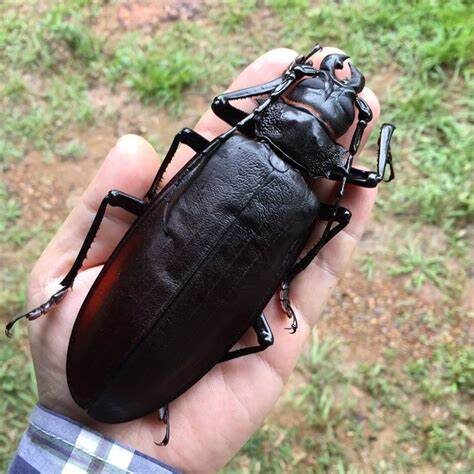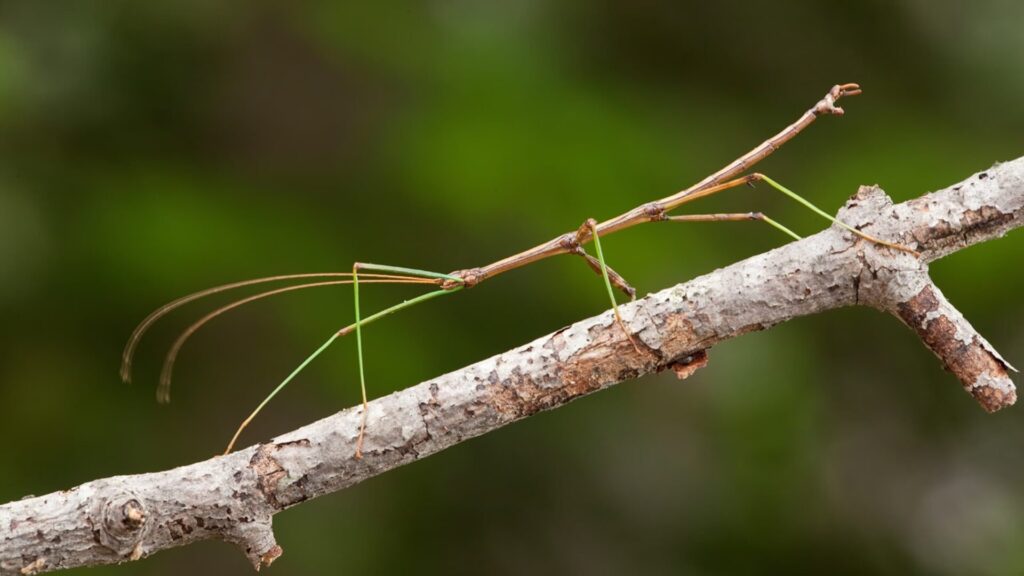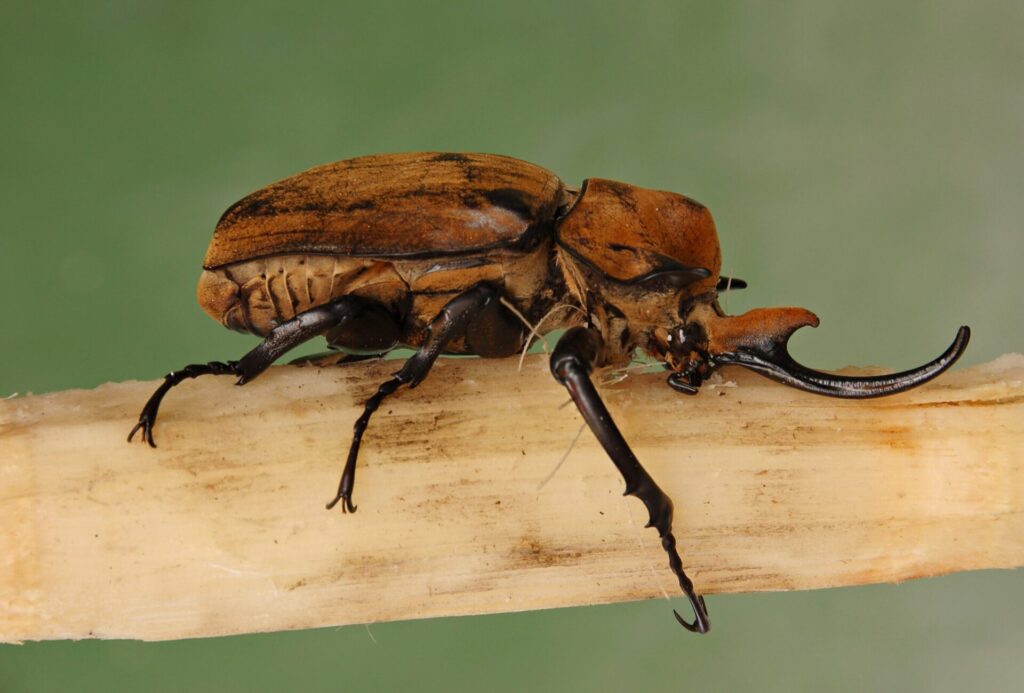
Certainly! Let’s delve into the amazing aiant insects in the world. These remarkable creatures come in various shapes and sizes, and their adaptations are awe-inspiring. Here are some of the most amazing giant insects:
Titan Beetle (Titanus giganteus)
The titan beetle (Titanus giganteus) is a remarkable Neotropical longhorn beetle, and it holds the distinction of being the largest known beetle in the Amazon rainforest. Since we talking amazing giant insects in the world; let’s explore some fascinating facts about this colossal insect:

- Size and Appearance:
- The titan beetle is truly gigantic, with the largest reliably measured specimen reaching an impressive 16.7 centimeters (6.6 inches) in length
- To put this into perspective, it’s comparable in size to other notable beetles:
- The giant Fijian long-horned beetle (Xixuthrus heros) measures around 15 centimeters (5.9 inches).
- The Hercules beetle (Dynastes hercules) occasionally boasts males that can grow up to 17.5 centimeters (6.9 inches), although the Hercules beetle males have an enormous horn on their pronotum or thorax, making up around half of their total length.
- The titan beetle’s body is considerably larger than that of the Hercules beetles.
- Its most striking feature is its short, curved, and sharp mandibles, which are known to snap pencils in half and even cut into human flesh
- Lifestyle and Behavior:
- Adult titan beetles do not feed; instead, they search for mates using pheromones while in flight. This is what made it into our list of the most amazing giant insects In the world.
- Surprisingly, the larvae of titan beetles have never been found. It is believed that they feed inside wood and may take several years to reach full size before pupating.
- These beetles are also thought to feed on decaying wood below the ground. Boreholes created by titan beetle larvae seem to fit a grub over two inches wide and perhaps as much as one foot long.
- Interestingly, a famous “life-sized” photograph of a putative larva of this beetle appeared in National Geographic magazine, but it turned out to be of a different species of beetle, possibly Macrodontia cervicornis
- Defense Mechanisms:
- When threatened, adult titan beetles defend themselves by hissing in warning and biting.
- They have sharp spines and strong jaws to deter potential predators.
- The beetle’s central nervous system structure includes a cephalic ganglion composed of the central brain and optic lobes, connected to the subesophageal ganglion (SOG). This structure is common among diurnal insects.
- Their large, complex eyes have structured optic and antennal lobes
- Distribution:
- The titan beetle is known from the rainforests of Venezuela, Colombia, Ecuador, Peru, the Guianas, and north-central Brazil.
- Its impressive size and mysterious lifestyle make it a captivating inhabitant of the lush Amazon rainforest.
Stick Insects (Order Phasmatodea)
Certainly! Let’s explore the fascinating world of stick insects, also known as Phasmatodea. Amazing Giant Insects In The World. These remarkable creatures have evolved incredible adaptations for survival. Here are some intriguing facts about them:

- Diverse Names and Camouflage:
- Stick insects are variously known as:
- Stick insects in Europe and Australasia.
- Stick-bugs, walking sticks, or bug sticks in the United States and Canada.
- Phasmids, ghost insects, or leaf insects (with the family Phylliidae) in general.
- Occasionally, they are also referred to as Devil’s darning needles, although this name is shared by both dragonflies and crane flies.
- Their natural camouflage makes them difficult for predators to detect. They resemble vegetation while being fascinating animals.
- Many species have secondary lines of defense, such as startle displays, spines, or toxic secretion.
- Stick insects are variously known as:
- Size and Diversity:
- Phasmids vary greatly in size:
- Females typically grow larger than males of the same species.
- The smallest species, like Timema cristinae, reach about 2 centimeters (0.8 inches) in length.
- The longest known species, informally called Phryganistria “chinensis”, can reach an astonishing 64 centimeters (25 inches) in total length, including outstretched legs. This makes it the world’s longest insect!
- The heaviest phasmid is likely Heteropteryx dilatata, with females weighing up to 65 grams (2.3 ounces)
- Phasmids vary greatly in size:
- Habitat and Behavior:
- Stick insects are found on all continents except Antarctica, but they are most abundant in the tropics and subtropics.
- They are primarily herbivorous, often living unobtrusively in the tree canopy.
- Their life cycle involves incomplete metamorphosis with three stages: egg, nymph, and adult.
- Many phasmids are parthenogenic, meaning female offspring can be produced without fertilized eggs.
- In hotter climates, they may breed year-round, while in temperate regions, females lay eggs in autumn before dying, and the new generation hatches in spring.
- Some species have wings and can disperse by flying, while others are more restricted.
- Remarkable Adaptations:
- Some phasmids have cylindrical stick-like shapes, while others resemble flattened leaves.
- Many species are wingless or have reduced wings.
Atlas Moth (Attacus Atlas)
Certainly! The Atlas moth (Attacus atlas) is a magnificent and captivating insect found in the forests of Asia. Amazing Giant Insect In The World. Let’s explore some fascinating details about this giant moth:

- Size and Appearance:
- The Atlas moth is one of the largest lepidopterans (butterflies and moths).
- It boasts an impressive wingspan of up to 24 centimeters (9.4 inches), making it a true giant in the moth world.
- Its wings have a surface area of approximately 160 square centimeters (≈25 square inches).
- The reddish-brown upper side of its wings features intricate patterns outlined in black, white, pink, and purple lines.
- Interestingly, females are significantly larger and heavier than males, and males have broader antennae
- Life Cycle:
- Eggs: Atlas moths lay spherical eggs (about 2.5 mm in diameter) on the undersides of leaves.
- Larvae: After hatching, the caterpillars feed on their eggshells and then consume foliage from citrus, cinnamon, guava, and evergreen trees.
- These caterpillars can grow up to 11.5 centimeters (4.5 inches) in length and have white, waxy, fleshy spines along their backs.
- Pupa: When they reach the appropriate size, the caterpillars pupate by spinning a papery cocoon interwoven with desiccated leaves. They attach the cocoon to a twig using silk.
- Adult Behavior:
- Atlas moths are weak and unsteady fliers. They conserve energy by resting during the day and flying at night.
- Interestingly, they lack fully formed mouthparts, so adults cannot eat. They rely solely on fat reserves accumulated during their larval stage.
- Their short adult life spans are dedicated to seeking out a mate. They release pheromones to attract potential partners.
- Males, equipped with feathery antennae, can detect these pheromones from several kilometers away.
- The body of the adult moth is small compared to its impressive wingspan.
- Atlas moths are most abundant between November and January
- Comparison to Other Moths:
- The Atlas moth is surpassed in wingspan only by the white witch (Thysania agrippina) and Attacus caesar.
- In terms of wing surface area, it is second to the Hercules moth (Coscinocera hercules).
- Despite its large size, it lives for only a few days, driven by the sole purpose of mating.
Goliath Beetle (Goliathus)
Certainly! Let’s explore the fascinating world of the Goliath beetles (Goliathus). Amazing Giant Insects In The World. These remarkable insects are among the largest and most impressive beetles on Earth. Here are some intriguing facts about them:

- Overview:
- The Goliath beetles are a group of six species found throughout Africa in tropical rainforests.
- They are named after the biblical giant Goliath due to their immense size.
- These beetles are masters of strength, capable of lifting objects up to 850 times their own body weight.
- Despite their large size, they are also capable fliers.
- Let’s dive into more details about these incredible insects! 🌿🪲
- Physical Characteristics:
- Size: Goliath beetles measure from 60–110 millimeters (2.4–4.3 inches) for males and 50–80 millimeters (2.0–3.1 inches) for females as adults.
- Weight: They can reach weights of up to 80–100 grams (2.8–3.5 ounces) during the larval stage, although the adults are only about half this weight.
- Color: Females range from a dark chestnut brown to silky white, while males are typically brown/white/black or black/white.
- Horns: Males have rounded heads with small, fork-shaped horns, while females lack these horns and have a more wedge-shaped head.
- Species:
- There are six recognized species of Goliath beetles:
- Goliathus albosignatus
- Goliathus cacicus
- Goliathus goliatus
- Goliathus kolbei
- Goliathus orientalis
- Goliathus regius (also known as the Royal goliath beetle)
- There are six recognized species of Goliath beetles:
- Life Cycle:
- Eggs: Females lay eggs in small depressions or burrows in damp soil or rotting wood.
- Larvae: The larvae feed on rotting wood, fruit, and animal remains. Some can reach up to 250 millimeters (9.8 inches) in length and are among the heaviest insects globally.
- Pupation: When maximum size is reached, the larva constructs a thin-walled, hardened cell of sandy soil for pupation.
- Metamorphosis: During the pupal stage, tissues break down and reorganize into the form of the adult beetle.
- Adults: Once metamorphosis is complete, the insect sheds its pupal skin and hibernates as an adult beetle until the dry season ends.
- Importance in Ecosystem:
- Goliath beetles play a crucial role in the ecosystem. Both the larvae and adult beetles provide food for a variety of predators, maintaining a healthy food chain in their environment.
Elephant Beetle (Megasoma elephas)
Certainly! The Elephant beetle (Megasoma elephas) is a remarkable member of the Scarabaeidae family, specifically the subfamily Dynastinae. Let’s explore some intriguing details about this colossal insect:

- Appearance:
- Elephant beetles are black in color and covered with a coat of fine microscopic hairs.
- These hairs grow particularly thick on the beetle’s elytra (wing covers).
- Males have three protruding horns: one from the head and two from the prothorax.
- The longest head horn gives the beetle its common name, as it resembles an elephant’s trunk.
- Females, on the other hand, have no horns.
- These horns are used for defense and in competition among males for food and mates
- Size and Range:
- Elephant beetles typically range between 7 and 12 centimeters (2.75–4.75 inches) in length, with the largest male specimen known measuring 13.7 centimeters, including the horn.
- They inhabit regions of southern Mexico, Central America, and South American rainforests
- Life Cycle:
- Eggs: Female elephant beetles lay their eggs inside decaying logs or in the ground.
- Larvae: After hatching, the eggs produce C-shaped larvae (white grubs with brown heads) that consume organic matter in the log.
- The larval stage lasts around 29 months.
- The pupal stage lasts around five weeks at a temperature of 26 degrees Celsius.
- The life span of an adult elephant beetle is around one to three months.
- Diet and Behavior:
- Elephant beetles feed on the sap of particular trees and ripened fallen fruits.
- In captivity, they also enjoy exotic fruits like pineapples, longan, and lychee, as well as bark from certain trees like the poinciana.
- These nocturnal beetles are mainly active during the night and can maintain a high internal body heat while foraging despite reduced ambient temperatures.
- Unfortunately, their population has been depleted due to rainforest destruction, affecting their grounds for mating
- Potential Military Use:
Next time you encounter an elephant beetle, appreciate its impressive size and unique adaptations—it’s a true marvel of nature! Learn more about Elephant beetles
You May Also Like
- 10 weirdest creatures you never knew existed.
- 10 Keys to Composure When Life Gets Wild
- 5 Festivals That Scare but Thrills
Conclusion
Remember, understanding the biology and lifecycles of insects is crucial for protecting biodiversity and habitat conservation. Let’s appreciate these unique species and work together to safeguard their ecosystems!
FAQs
What is the heaviest and largest adult insect in the world?
The giant weta native to the Little Barrier Island of New Zealand is the heaviest and largest adult insect in the world, the record weight for one being of 71 grams or 2.5 oz and more than 8.5 centimeters or 3.4 inches in length.
What is the largest beetle in the world in terms of sheer body size?
The titan beetle ( Titanus giganteus ) from the Amazon rainforest is the largest beetle in the world in terms of sheer body size, growing up to 6.6 inches long.
What is the longest insect in the world?
The longest insects on the planet are members of the order Phasmatodea, commonly known as stick insects, which have evolved a bizarre shape to hide from predators among branches, twigs, and foliage. The world record for the longest insect is held by the species Phryganistria chinensis, which was discovered in China in 2016, with one specimen measuring 25.2 inches.
What is the largest bee in the world?
The largest bee in the world is Megachile pluto, also known as Wallace’s giant bee, which is found in Indonesia and has a wingspan of over 6cm across.
What is the largest ant in the world?
The largest ant in the world is the male driver ant ( Dorylus spp ) from East Africa, which is known locally as a sausage fly due to its meaty body. It can reach lengths of around 6.3cm or 2.4in.


